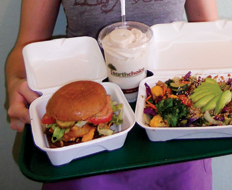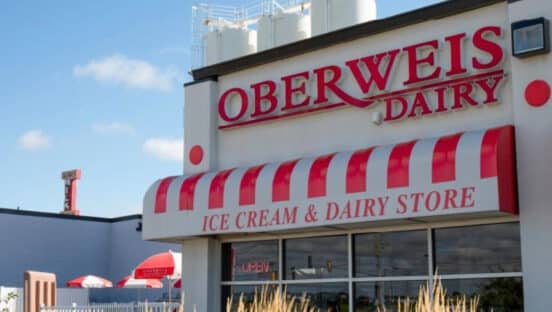The sustainability movement is in full swing in the quick-serve industry, and as operations look for ways to go green, many are opting for systems that reduce the amount of waste that comes out of their stores and turns up in landfills.
While composting and recycling programs do plenty of good for the planet, some restaurateurs are finding that controlling the amount of food that becomes waste in the first place can be more cost-efficient.
LeanPath, a Portland, Oregon–based food tracking company, estimates quick-serve restaurants could reduce food costs by as much as 10 percent through weighing and tracking the food they’re wasting. Andrew Shakman, president and CEO of LeanPath, developed a series of waste-auditing tools for commercial foodservice companies to do this.
With customers in 28 states, “adoption is still pretty early,” Shakman says, but he also sees “massively growing interest in food waste prevention.”
“Sodexo Inc., in a pilot project at eight [college] campuses in 2010, reduced food waste 30 percent,” says Jean Schwab, program manager for the GreenScapes Program with the U.S. Environmental Protection Agency (epa). “The whole concept of tracking the waste you are generating can make a huge difference. It’s the No. 1 thing that goes into landfills.”
Bill Kuecker, food sales group manager for Sealed Air Corporation’s Cryovac Division, says that “every penny counts” in foodservice operations, which explains why many operators are starting to look into food waste prevention.
“Every chain I work with is focused on it, and packaging is certainly a significant factor,” he says.
When food waste control is combined with a growing consumer desire for fresh, never-been-frozen food, Kuecker says, “the packaging can be absolutely critical to controlling food waste. Certainly we think of spoilage associated with fresh food, but there is opportunity with frozen food as well, in reducing freezer burn. It’s certainly not a one-size-fits-all [situation]. The focus is shift-by-shift operations, with every shift and every day generating a food waste report. We’re also seeing a greater emphasis on right-sized packaging.”
LeanPath’s ValuWaste Automated Food Waste Tracking System combines scales and a touch screen with a back end that “offers useful analytical insights,” Shakman says. “Waste tracking is a good practice that is well known and understood. You need to make sure the behavior in the operation [is treated] just like sanitation.”
LeanPath’s concept caught the eye of Seattle Public Utilities in 2009, leading to a grant for a trial at the Swedish Medical Center First Hill Campus in Seattle. The hospital’s executive chef, Eric Eisenberg, was initially skeptical about the product. “Weighing everything seemed so cumbersome,” he says. “It just seemed impossible.”
Once Eisenberg had detailed data on how much food was discarded and why, food costs fell by double digits. In the first month, he reduced production of baked goods by 43 percent, deli meats by 50 percent, salads by 40 percent, and sandwiches by 75 percent.
“We were just plain making too much food,” Eisenberg says. “In a nutshell, we experienced a great deal of awareness of what we were throwing away.”
But without the employees’ participation, there is no data, Eisenberg says. “So we really train them to be doing the weighing. It only takes a few seconds per transaction. The scale is programmed with all the possible pan sizes, shapes, and all the tare weights.” Before throwing a food away, an employee selects the container, the food item, and the reason for discard, and “each one takes seven or eight seconds,” Eisenberg says. “You want to see consistent transactions, but you want to see them weigh less—weighing half as much as the day before.”
“Getting a handle on data daily is the key,” Shakman says. “POS systems do not provide sufficient granularity to drive a change in employee behavior.” When employees become engaged with the tracking process, he says, they begin to view food as a precious commodity.
Food is definitely a precious commodity at VG Burgers, says Timothy Gargiulo, CEO of the one-store concept in Boulder, Colorado, that has plans to expand to more locations. Touting its zero-waste efforts, the company’s quick-serve menu is mostly organic and plant-based.
“Organic is costly, and there’s no room for us to be throwing food out,” Gargiulo says. “I can say without a doubt that we do not fill up a 55-gallon trash bag in two months.” All eating utensils and plates are compostable, he says. “We don’t even pay for a trash service.”
“Food waste is the No. 1 material in municipal solid waste streams,” says Laura Moreno, an environmental scientist with the EPA Prevention and Solid Waste Office in the EPA’s Pacific Southwest Region, based in San Francisco. “There are 33 million tons of it each year, and only 2.5 percent [nationally] is diverted.” Also troubling is the methane gas it creates, which she says is 21 times more potent than carbon dioxide.
Ron Cotterman, executive director of sustainability at Cryovac, says packaging that helps prevent food waste on the consumer end is important, as most of the consuming public is unaware of the amount of waste that is turning up in the landfills. “If people understood the economic impact of 25 percent of everything you bought you put in the trashcan, they’d be shocked,” he says. “Forty percent of [food] product is not consumed.”
He says Cryovac’s packaging products are 50 percent thinner compared with 15 years ago.
“There are all kinds of conflicting messages consumers are experiencing,” Kuecker says about green efforts like food waste control. “Preventing food waste is more complex. It’s more of a compass than a speedometer. Is it about getting there faster, or just getting to the wrong place more quickly?
“We felt very strongly that we need to help customers sort through these conflicting ideas. There’s still an early understanding of how packaging can affect things upstream. The industry is more efficient. There are more holistic managers on the upstream side,” he says.













